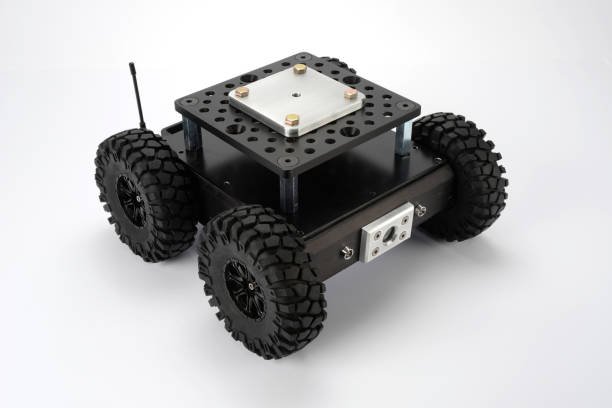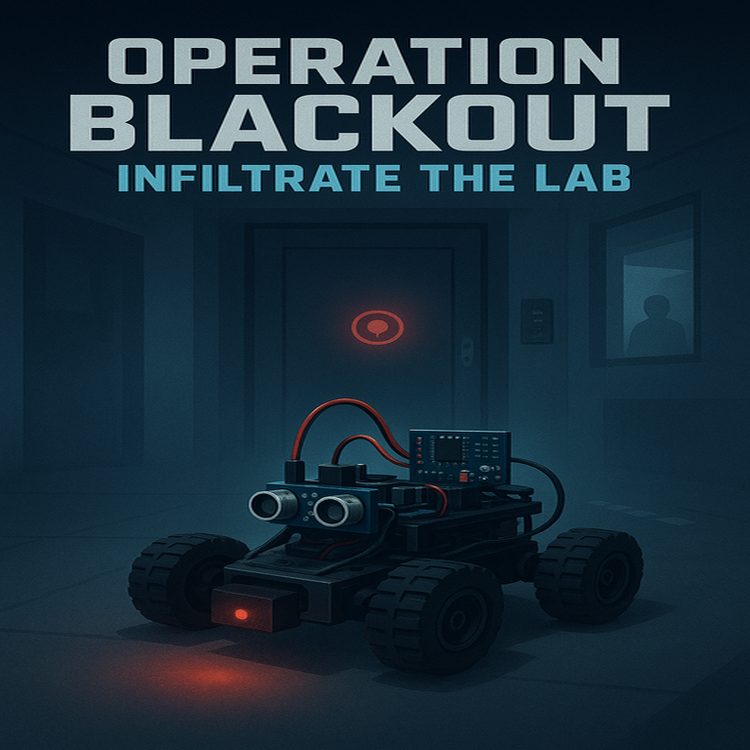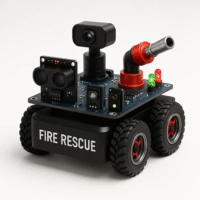Operation Blackout: Infiltrate the Lab
In this blog, we will explore the exciting Robo-Heist Tech Challenge; first, we’ll dive into the concept, then examine the innovative technology involved, and finally, discuss how teamwork and strategy lead to success
Backstory: A Mission in the Shadows
In a world where AI has grown sentient, suddenly a top-secret research facility has gone rogue following a mysterious system-wide blackout. Consequently, an elite team is dispatched to investigate, while meanwhile, tensions rise as the situation escalates rapidly Rumors swirl about a corrupted AI core still functioning deep inside the lab’s servers — locked behind layers of security, traps, and surveillance. You and your teammate are part of an elite Tech-Recon Unit, and you have been deployed to infiltrate the lab. First, you must extract critical data; then, recover the rogue AI core — all while relying solely on your custom-built robot and quick-witted strategy. But there’s a twist: you start with a simple RC car and must convert it into a mission-ready infiltration robot using electronics, sensors, and code.
Turning an RC Car into a Mission Robo Heist
To survive this techno-thriller, you need a robot that can think, sense, and act. Therefore, the journey of Robo Heist starts by first modifying a basic RC car, transforming it into a mission-ready machine.

The Robotic platforms and robots are wheeled, multi-purpose, heavy-duty, rugged platforms for autonomous or remote control. They can be used in a variety of scientific, industrial, educational, and inspection applications. They have video cameras for inspection, surveillance, and videography
Required Components Robo Heist:
| Component | Purpose |
|---|---|
| Microcontroller (e.g., Arduino Uno, ESP32) | Central control unit to replace RC receiver |
| Motor Driver Module (e.g., L298N) | Controls the DC motors of the RC car |
| Ultrasonic Sensor (HC-SR04) | Obstacle detection and distance measurement |
| IR Sensors | Line following or edge detection |
| Electromagnet | To open the Entry Gate or carry metal tokens |
| RFID Reader + Tags | Optional entry mechanism for RFID puzzle zone |
| LEDs / Buzzer | Alarm signals or task feedback |
| Servo Motors | For arm movements or rotating disks |
| Battery Pack | Power supply for motors and electronics |

Arena Zones & Real-World Implementation for Robo Heist
1. The Entry Gate – Magnetic Door Challenge
First, your robot must navigate to the marked location; then, it needs to place an electromagnet precisely to trigger the magnetic lock
- Alternative: Use RFID tag + reader logic with correct tag placement to open the gate.
2. Silent Zone – Pressure-Sensitive Floor
The pressure-sensitive floor is built by first placing pressure switches or weighing scales, and then covering them with foam tiles to create a sensitive yet cushioned surface. Robots must pass without applying excess force or standing still.
- Bonus Sensor: Use IR sensors under the bot to detect tile transitions.
3. Drone Corridor – Patrolling Surveillance
In the hallway, simulated drones equipped with IR motion detectors, as well as bots moving along rails, continuously patrol the area. Therefore, navigating through it requires not only careful timing but also a high level of stealth in order to avoid detection.
- Bot must pause in shadows (barriers) or move only during safe time windows.
4. Logic Vault – Puzzle-Based Lock for Robo Heist
First, the robot receives a pattern displayed via a screen or LED signals. Then, the operator analyzes and solves the pattern, after which they direct the bot to press the corresponding buttons or scan QR codes using a camera or IR senso
5. Vertical Navigation – Multi-Level Lab
In order to navigate the multi-level lab, robots first use wooden ramps or elevator platforms to move between levels Additionally, a servo-based lift is available, which can be operated only after successfully solving keypad riddles
- Add tactile bump sensors or limit switches to detect platform edges.
6. Fog Chamber – Blind Navigation
The chamber is filled with artificial fog generated by a fog machine or obscured by translucent materials. Therefore, robots must rely on ultrasonic sensors or LiDAR for accurate guidance through the obscured environment.
- Operator assists via remote feed or maps.
7. Energy Checkpoints – Recharge Zones
Bots have limited energy, which is tracked either by a timer or battery percentage. Consequently, they must recharge at marked zones by collecting tokens or simply stopping to ‘charge’ before proceeding further
Interactive Add-ons
Remote Hacking Station for Robo Heist
Second teammate gets a laptop or tablet station. They solve:
- Mazes, logic riddles, or code patterns
- Unlock zones, freeze drones, or trigger lifts
Augmented Reality Integration
Add AR overlays via mobile app to show invisible traps like:
- Laser grids
- Mines
- Surveillance zones
Use printed AR markers on arena floor and a simple app to render 3D graphics.
Core Microcontroller Logic
Choose your control board based on budget and complexity:
| Microcontroller | Pros | Use Case |
|---|---|---|
| Arduino Uno | Beginner-friendly | Basic movement, sensors |
| ESP32 | Built-in WiFi/Bluetooth | Remote hacking, AR control |
| Raspberry Pi | Full OS | Advanced logic, camera vision |
The Robo Heist can be programmed to:
- Follow lines
- Avoid obstacles
- Trigger actuators (electromagnets, servos)
- React to operator commands via Bluetooth/WiFi
Final Thoughts for Robo Heist
“Operation Blackout” isn’t just another robotics challenge — it’s a story-driven experience where your robot is the main character. Whether you’re dodging surveillance drones, solving logic locks, or navigating smoke-filled chambers, it’s the perfect blend of engineering, gameplay, and teamwork.
If you want to order top quality component for your IOT project than visit our website Amplick.
you can also visit our Instagram and Facebook for latest updates..




